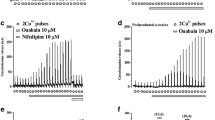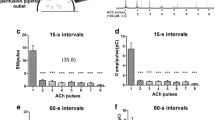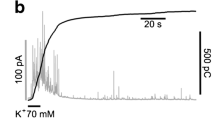Abstract
In isolated chromaffin cells, the high-voltage-activated Ca2+ current, recorded using 5 mM Ca2+ as the divalent charge carrier, exhibits rundown within 10 min, which is delayed for 1 h at least by the addition of 1 mM adenosine 5′-triphosphate (ATP) to the pipette medium. The mechanism of this stabilizing action of ATP has been examined. ATP action is dose dependent; the rundown process, which was delayed at concentrations below 0.4 mM, was totally abolished at higher concentrations. The requirement for ATP was shown to be quite strict: 2 mM inosine 5′-triphosphate (ITP) could not replace ATP, whereas guanosine 5′-triphosphate (GTP) could, but at higher concentrations. This effect of ATP was shown to require the presence of MgCl2 and the liberation of a phosphate group since the ATP analogue 5′-adenylyl-imidodiphosphate (AMP-PNP) could not act as a substitute for ATP, suggesting an action through either adenosine 5′-diphosphate (ADP) or a phosphorylation step. ADP, in the presence of Mg2+ only, could replace ATP in the same concentration range. This effect was shown to be specific to ADP; it was maintained after blocking the pathways which convert ADP into ATP, and could not be mimicked by guanosine 5′-diphosphate (GDP). Similarly, ATP and ADP effects were abolished at an increased internal Ca2+ concentration (pCa 6 instead of pCa 7.7, where pCa = −log10[Ca2+]). Nevertheless, the presence of 1 mM Mg-ADP in the bathing solution did not prevent the rundown of the Ca2+ channels when going to the inside-out patch recording configuration. In conclusion, the stabilizing effect of ATP may be interpreted by a Mg2+-ADP binding site present on high-voltage-activated Ca2+ channels. A localization of such an ADP regulatory site on the L-type Ca2+ channel itself cannot be excluded, though with an additional requirement since Mg-ADP alone is not able to maintain the corresponding activity on excised patches.
Similar content being viewed by others
References
Armstrong D, Eckert R (1987) Voltage-activated calcium channels depolarization. Proc Natl Acad Sci USA 84:2518–2522
Artalejo CR, Adams ME, Fox AP (1994) Three types of Ca2+ channel trigger secretion with different efficacies in chromaffin cells. Nature 367:72–76
Bader MF, Ciesielski-Treska J, Thierse D, Hesketh JE, Aunis DJ (1981) Immunocytochemical study of micro tubules in chromaffin cells in culture and evidence that tubulin is not an integral protein of the chromaffin granule membrane. J Neurochem 37:917–933
Belles B, Hescheler J, Trautwein W, Blomgren K, Karlsson JO (1988) A possible physiological role of the Ca-dependent protease calpain and its inhibitor calpastatin on the Ca current in guinea pig myocytes. Pflügers Arch 412:554–556
Bossu JL, De Waard M, Feltz A (1991) Inactivation characteristics reveal two calcium currents in adult bovine chromaffin cells. J Physiol (Lond) 437:603–620
Bourinet E, Fournier F, Lory P, Charnet P, Nargeot J (1992) Protein kinase C regulation of cardiac calcium channels expressed in Xenopus oocytes. Pflügers Arch 421:247–255
Breitwieser G, Szabo G (1988) Mechanism of muscarinic receptor-induced K+ channel activation as revealed by hydrolysis-resistant GTP analogues. J Gen Physiol 91:469–493
Chad JE, Eckert R (1986) An enzymatic mechanism for calcium current inactivation in dialyzed Helix neurons. J Physiol (Lond) 378:31–51
Cook DL, Hales CN (1984) Intracellular ATP directly blocks K+ channels in pancreatic β cells. Nature 311:271–273
Dufy B, Mac Dermott A, Barker JL (1986) Rundown of GH3 cell K+ conductance response to TRH following patch-recording can be obviated with GH3 cell extract. Biochem Biophys Res Commun 137:388–396
Dunne MJ, Petersen OH (1986) Intracellular ADP activates K+ channels that are inhibited by ATP in an insuline secreting cell line. FEBS Lett 208:58–62
Elhamdani A, Bossu J-L, Feltz A (1995) ATP and G proteins affect the runup of the Ca2+ current in bovine chromaffin cells. Pflügers Arch 430:410–413
Elmslie KE, Werz MA, Overholt JL, Jones SW (1993) Intracellular ATP and GTP are both required to preserve modulation of N-type calcium channel current by norepinephrine. Pflügers Arch 423:472–479
Fabiato A (1988) Computer programs for calculating total specified free or free form specified total ionic concentrations in aqueous solutions containing multiple metals and ligands. Methods Enzymol 157:387–417
Fenwick EM, Marty A, Neher E (1982) Sodium and calcium channels in bovine chromaffin cells. J Physiol (Lond) 331: 599–635
Hadley RW, Lederer WJ (1991) Properties of L-type Ca channel gating current in isolated guinea pig ventricular muscle. J Gen Physiol 98:265–286
Imagawa T, Leung AT, Campbell E (1987) Phosphorylation of the 1,4-dihydropyridine receptor of the voltage dependent Ca2+ channel by an intrinsic protein kinase in isolated triads from rabbit skeletal muscle. J Biol Chem 262:8333–8339
Johnson BD, Byerly L (1993) A cytoskeletal mechanism for Ca2+ channel metabolic dependence and inactivation by intracellular Ca2+. Neuron 10:797–804
Kakei M, Kelly RP, Ashcroft SJH, Ashcroft FM (1986) The ATP-sensitivity of K+ channel in rat pancreatic β-cells is modulated by ADP. FEBS Lett 208:63–66
Kameyama M, Kameyama A, Nakayama T, Kaibara M (1988) Tissue extract recovers cardiac calcium channels from “rundown”. Pflügers Arch 412:328–330
Lacerda AE, Rampe D, Brown AM (1988) Effects of protein kinase C activators on cardiac Ca2+ channels. Nature 335: 249–251
Levitan IB (1985) Phosphorylation of ion channels. J Membr Biol 87:177–190
Misler S, Falke LC, Gillis K, McDaniel ML (1986) A metabolite-regulated potassium channel in rat pancreatic β cells. Proc Natl Acad Sci USA 83:7119–7123
Noma A (1983) ATP-regulated K+ channels in cardiac muscle. Nature 305:147–148
O'Rourke B, Backx PH, Marban E (1992) Phosphorylation-independent modulation of L-type calcium channels by magnesium-nucleotide complexes. Science 257:245–248
Ono K, Fozzard HA (1992) Phosphorylation restores activity of L-type calcium channels after rundown in inside-out patches from rabbit cardiac cells. J Physiol (Lond) 454:673–688
Reuter H, Scholz H (1977) The regulation of the calcium conductance of cardiac muscle by adrenaline. J Physiol (Lond) 264:49–62
Romanin C, Grosswagen P, Schindler H (1991) Calpastatin and nucleotides stabilize cardiac calcium channel activity in excised patches. Pflügers Arch 418:86–92
Trautwein W, Hescheler J (1990) Regulation of cardiac L-type calcium current by phosphorylation and G proteins. Neuron 9:1041–1052
Trube G, Hescheler J (1984) Inward-rectifying channels in isolated patches of the heart cell membrane: ATP-dependence and comparison with cell-attached patches. Pflügers Arch 401: 178–184
Yakel JL (1992) Inactivation of the Ba current in dissociated Helix neurons: voltage dependence and the role of phosphorylation. Pflügers Arch 420:470–478
Yatani A, Codina J, Imoto Y, Reeves JP, Birnbaumer L, Brown AM (1987) A G protein directly regulates mammalian cardiac calcium channels. Science 238:1288–1292
Author information
Authors and Affiliations
Rights and permissions
About this article
Cite this article
Elhamdani, A., Bossu, J.L. & Feltz, A. ADP exerts a protective effect against rundown of the Ca2+ current in bovine chromaffin cells. Pflügers Arch 430, 401–409 (1995). https://doi.org/10.1007/BF00373916
Received:
Revised:
Accepted:
Issue Date:
DOI: https://doi.org/10.1007/BF00373916




